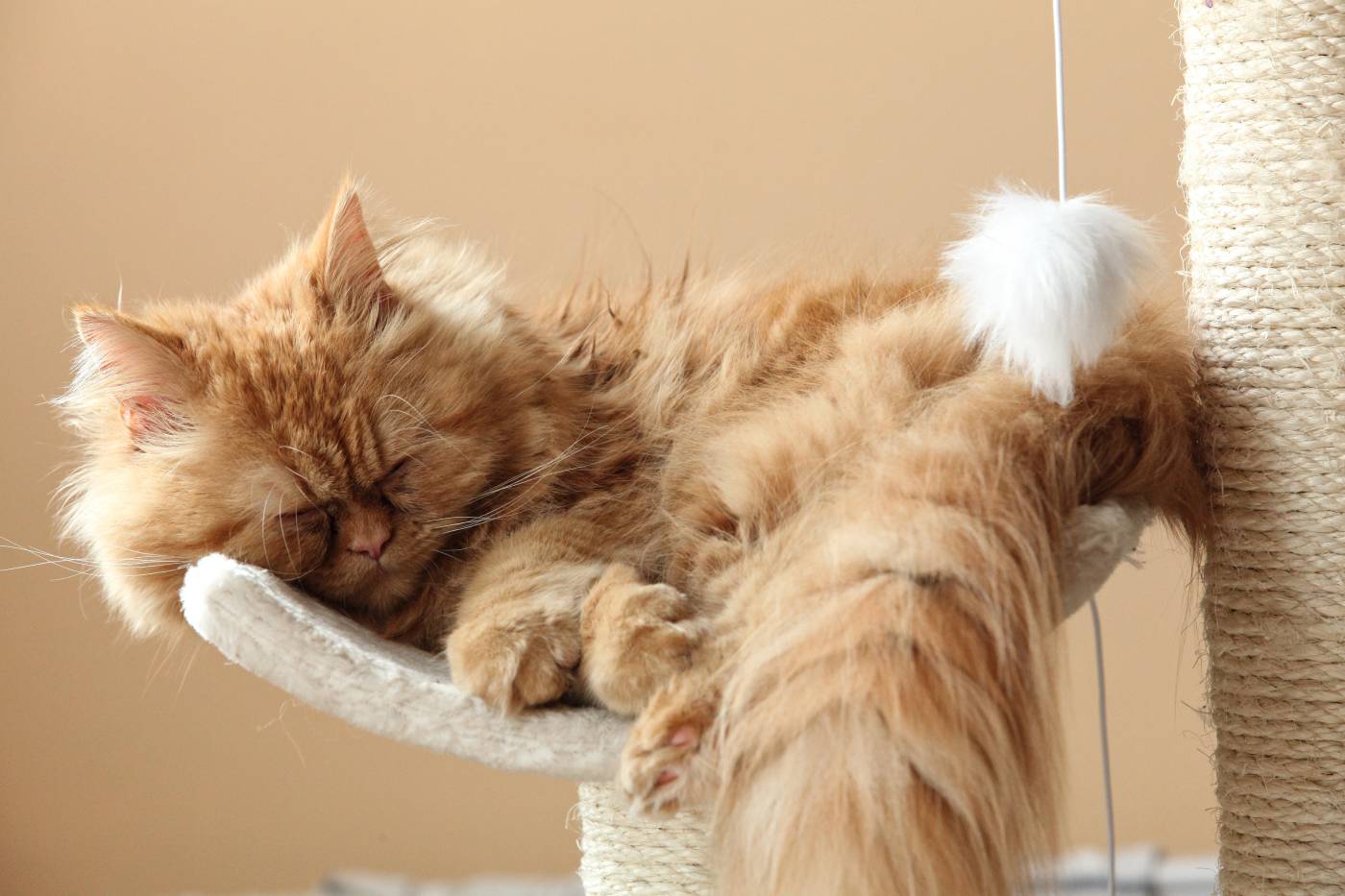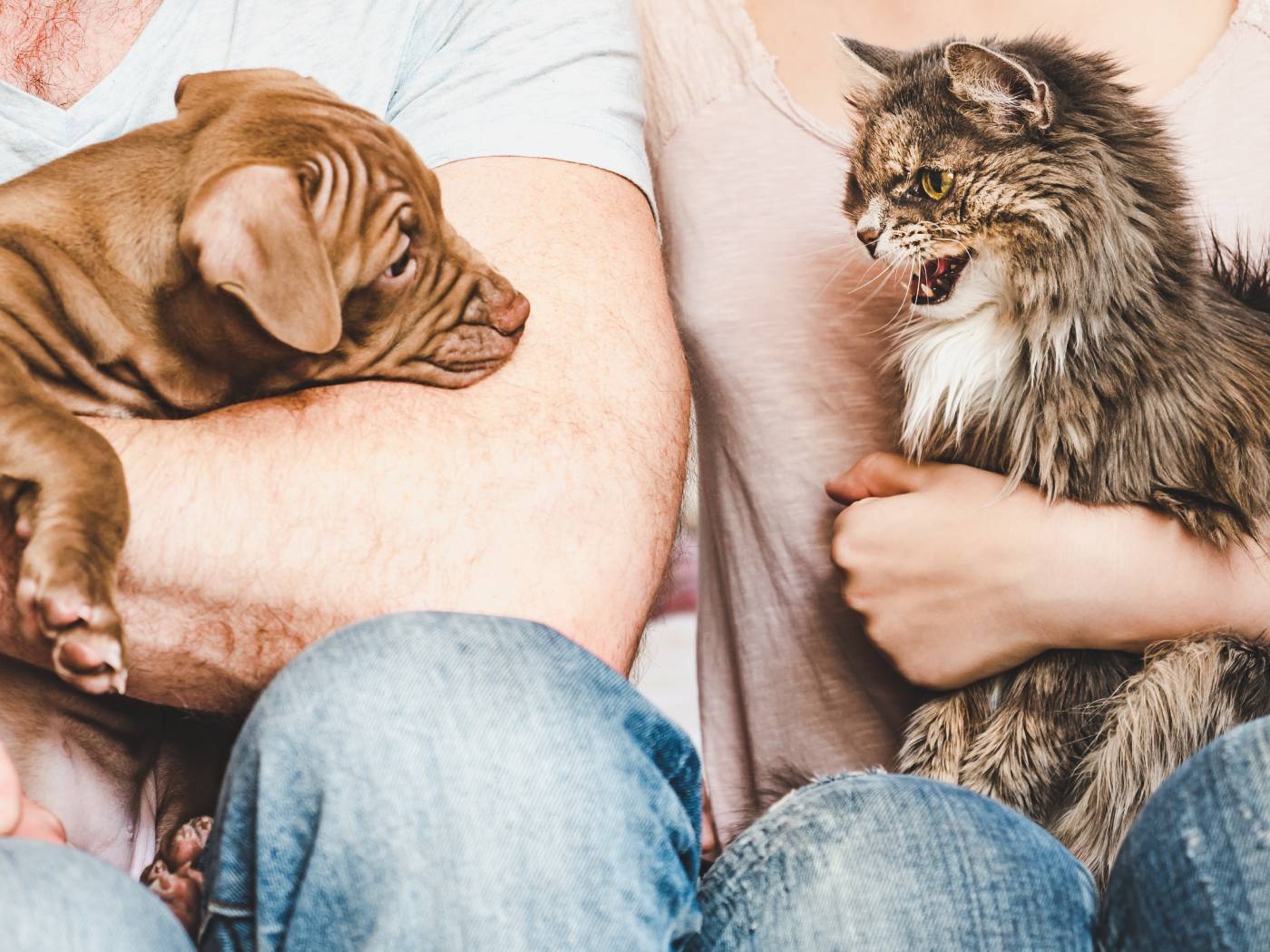If you want your cat and your dog to live peacefully under the same roof, it is important to properly introduce them to each other. In this article, you’ll learn how to introduce your dog to your cat and maximize the chances of a successful introduction.
There’s no doubt that a dog and a cat can become friends, or at least treat each other calmly. The success here depends on us, humans.
How do you introduce a kitten to an adult dog?
As a rule, kittens, so long as they haven’t had a negative past experience in interacting with dogs, are open to new canine acquaintances. So, if your dog doesn’t show any signs of aggression, their first meeting can go smoothly. When introducing your dog to a kitten, follow these steps:
- Bring a carrier with your kitten into your house and let your dog sniff it. Watch their reaction.
- Prepare a dog-free space for your new kitten. The space should include a litter box, scratching post, water, food bowl, and toys. Let your kitten out of the carrier here.
- Restrict the dog’s access to the kitten’s room.
- Don’t leave your pets together without your supervision. This way, your dog doesn’t have a chance to hurt the kitten.
- Make sure your kitten doesn’t disturb your dog while they are eating.
- Don’t pay less attention to your dog than you used to. It is important that your dog does not feel neglected because of a new tenant.
How do you introduce an adult cat to an adult dog?
It’s a bit more difficult to introduce an adult cat to your adult dog because an adult cat might’ve had a negative past experience interacting with dogs. On top of that, as a rule, adult dogs are more aggressive to adult cats than to kittens.

- Prepare a dog-free space for your new cat. The space should include a litter box, scratching post, water, food bowl, and toys.
- Spend some time in this room with your cat to leave your smell and mix it with the smell of the cat.
- Block all potential hiding places. However, provide your cat with boxes or special houses as an alternative.
- When you bring a new cat home, let them out only in the space specially prepared for them.
- Before meeting each other, your dog and your cat should be as relaxed as possible. Have a long walk or play a brain game with your dog. You can give a mild sedative to your cat after a consultation with a vet.
- Feed your dog and your cat on opposite sides of a closed door. Observe the reaction of your pets. If they feel uncomfortable, increase the distance.This way, both your cat and your dog will get used to each other’s smell.
- Put rags with your cat’s scent close to the place where your dog eats and vice versa. This will create a positive association with the smell of the other animal.
- When you feed your pets, slightly open the door so that they can see each other. It is important to monitor the reaction of both animals to avoid fear or attempts to attack.
- When you take your dog for a walk, ask someone to let the cat out of the room, so that they can walk around the house and examine it. You should also let your dog take a tour in your cat’s room, but only when the cat is not there.
- Introduce your dog to your cat in one room. This room should be a neutral ground. You can put a barrier between them, for example, a baby playpen. If you are sure that your cat won’t try to attack your dog you can put the dog on a leash and put on a muzzle. If you are unsure of your cat’s behavior, you can put them in a carrier. It is important that both pets are calm before their face-to-face meeting. Ideally, one person should watch the dog and one should watch the cat. Talk slowly and calmly. Your movements should be smooth and soft. Give your pets time to look at each other. Praise them and give them treats for their calm behavior. From time to time, switch your pet’s attention to yourself. It is important to do so to make sure that your dog can doesn’t fixate on or stare at the cat, as if getting ready to attack. It is better if the first face-to-face encounter lasts no longer than a few minutes.
- Make your pets’ encounters frequent but keep them short. The first ones shouldn’t last longer than five minutes.
- Always reinforce your dog’s calm behavior. If you wait until your dog gets excited, starts barking, or rushes toward the cat, and then punish them for such behavior, they will associate negative consequences with the cat and all your previous efforts will be in vain.
- Pay attention to your pet’s behavior and body language. It is important to not let your pets get over excited and come to the point where it’s difficult for them to bear each other’s presence and control themselves. Your pets’ encounter should be over if you see the first signs of overexcitement.
- When both your cat and your dog are calm while in the same room, you can pet and play with them in the presence of each other. This way, they will be able to observe each other and associate the presence of the other pet with pleasant things. Take your pets’ favorite treats and temporarily give these treats only in this particular situation. If you see tension between your pets, end the encounter.
- Gradually bring items from the cat’s room to other rooms. Let your cat access them, but restrict your dog’s access to the cat’s room. For example, you can leave a gap in the door to the cat’s room so that the cat can go there, but the dog can not.
- At first, keep your pets separate if you can’t manage their interactions. It is important to avoid uncontrolled situations in which one of the animals may form a negative experience.
The duration of each stage depends on the behavior of both animals.
Take your time! It is better to spend more time in the beginning, but do everything smoothly and without stress, than to rush and make your dog and cat be suspicious, or even hateful of each other. It will take more time to adjust negative behavior and it may be dangerous for your pets’ health or even their lives.

If anything goes wrong, go back to the previous stage.
If you bring a puppy to the house where an adult cat lives
- Before bringing a puppy home, make sure that your cat has enough opportunities to avoid conflict. Your cat should have access to a puppy-free sanctuary at all times.
- Keep your puppy in a separate room for a few days.
- Play with your puppy but don’t let them bother your cat with active games.
- If your puppy is chasing your cat, call them back and switch their attention to a toy.
If you bring an adult dog to the house where an adult cat lives
- Before bringing a dog home, make sure that your cat has enough opportunities to avoid conflict. Your cat should have access to a dog-free sanctuary at all times.
- If you need to make some rearrangements in your house to help your dog settle in, do it in advance. Rearrange things gradually, moving the cat’s things little-by-little.
- Your cat should know for sure where their litter box, scratching post, water, food bowl, and toys are located. It is important that your cat knows exactly where these items are located, and that they have safe access to them.
- Make sure that your dog doesn’t corner your cat.
- Your cat should always have the opportunity to hide from the dog in a dog-free sanctuary.
- When you bring your dog for the first time, it is important that your cat does not run out to meet you. It is better to keep your cat in a separate room when you arrive.
- Once the dog has taken a look around and sniffed everything, you can take them to the room where the cat is. It is important that your dog is on the leash and in a muzzle.
- Praise your dog for their calm behavior to distract from the cat and redirect attention to you.
- If both your cat and your dog are calm, let them sniff each other.
- Praise your pets and give them some treats if everything goes smoothly.
- Your pets’ first interactions shouldn’t last longer than several minutes. For the first few days, keep your cat and dog in separate rooms, letting them meet 2 to 3 times a day.
- If your cat or dog shows aggression, move their acquaintance through stages. Begin with feeding on opposite sides of a closed door and sharing their smells through rags. It is also important to understand the type of your dog’s aggression. It can be predatory aggression, fear aggression, or resource guarding.
What do you do if your dog shows predatory aggression to your cat?
Predatory aggression is a dangerous issue, In this case, a dog may even kill a cat. That’s why it is extremely important to keep both your pets safe. What do you do in this case?
- Safety is most important. Manage all your pets’ interactions and never let them stay together unattended.
- Let your dog watch your cat in a safe environment. For example, your dog should be on the leash or in the muzzle. You can also set a barrier between your pets. You can use a child’s playpen, for example.
- Choose the distance at which your dog can watch your cat without rushing at them. If your dog loses control, increase the distance.
- Praise your dog for turning their back on the cat.
- Shorten the distance gradually.
- Start walking across the room. Vary the range until you find the distance at which the dog can pass the cat without reacting to them. Reinforce this behavior and gradually reduce the distance.
- Let your dog sniff your cat while wearing its muzzle. Do so only if the dog is calm.
- Keep your dog on the leash and let your cat walk across the room. Reinforce your dog’s calm behavior.
- If your dog reacts to your cat calmly, let them off the leash and let them stay together in a room under your supervision.
- Mind your pets’ body language and behavior. Notice the slightest signs of your dog’s overexcitement and stop your pets’ interactions if this occurs. Don’t let your pets form a negative experience with each other.
Keep in mind that correcting such aggressive behavior requires quite a lot of time. So, please, be patient.
What do you do if your dog or your cat suddenly begins to behave aggressively?
It seems that your dog and cat have a peaceful and friendly relationship but suddenly, for no obvious reason, one of your pets begins to behave aggressively towards the other. What do you do in this case? Well, it depends on the reason for this behavior.
- Eliminate the illness. It is quite possible that sudden irritability is a sign of sickness. To make sure that your pets are healthy, consult a veterinarian.
- Analyze what preceded the manifestation of aggression. Maybe one of the pets was at the veterinarian’s office and brought home a stranger’s smell with them. In this case, it is better to keep your pets separate until one of them gains the “smell of the pack” back.
- There may be a case of redirected aggression. For example, your dog might have been overexcited and your cat was in the wrong place at the wrong time, or vice versa. In this case, you’ll need to go through all the meeting stages again to show your pets that they are safe around each other, and to develop positive associations with their communication.
What do you do if your dog growls at your cat?
- Make sure that your dog is not ill. Sudden irritability may be a sign of disease.
- Take a look where your dog growls at your cat. Is it always happening in the same places? If so, make sure that your pets aren’t in competition for important resources and do not meet at certain points. For example, if your pets run to meet you and get in each other’s way, this can become a source of discontent. In this case, it is necessary to provide the cat with other, oftentimes higher, pathways to move around in places of conflict.
- Monitor your dog’s behavior and don’t wait until your dog starts growling.Take your cat away when you see the first signs of your dog’s discontent.
- Always praise your dog for a calm reaction to the cat.
What do you do if your cat is aggressive to your dog?
Usually, cats react aggressively to dogs out of fear. What do you do in this case?

- Don’t punish your cat. It will only make the matter worse.
- Prevent situations in which your cat may act aggressively. (For example, think about how to properly allocate territory so that your cat has safe, free access to important resources and does not find themselves cornered.
- Build up your cat’s positive associations with the presence of your dog.
- If aggression occurs in the same places, find some items that will allow your cat to avoid those places by moving above the floor.
- Do not place the cat’s bed where it is convenient for them to reach the dog with their paws.
What do you do if your cat and dog play rough with each other?
If your dog plays rough with your cat it may spoil their relationship and end up in injuries. What do you do in this case?
- Let your dog play but in a safe way. For example, let them play with you, other dogs, and safe toys.
- Provide your cat with a dog-free sanctuary, located high overhead, as it is impossible for your dog to reach it.
- Always reinforce your dog’s safe interactions with your cat.
